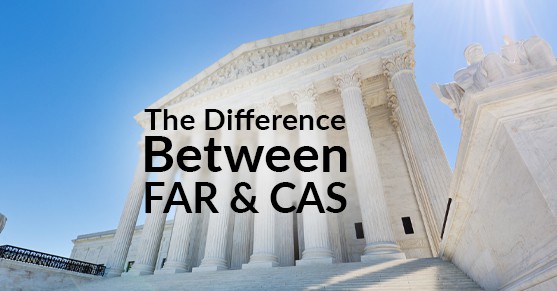During a recent webinar on DCAA compliance, one of the attendees asked our team what the difference was between Federal Acquisition Regulation (FAR) and Cost Accounting Standards (CAS). As we answered the webinar guest’s question, we realized that it’s a common concern for many businesses new to the government contracting industry. As new contractors begin winning bids, the necessary levels of compliance and list of contract-related regulations pile on, and FAR and CAS are predominant in our client discussions.
While tools like Microsoft Dynamics 365 for Government Contractors are pivotal resources for maintaining compliant accounting systems and documentation for FAR and CAS, understanding their differences is vital. As you begin to win bids with the government and accrue larger contracts, keep in mind the following distinctions.
What is FAR?
Simply put, FAR outlines the way government contractors are allowed to charge the government for specific contracts (i.e., is it the type of cost the government will pay). It serves as a safeguard to consistency and standardization for any contract with the Executive Branch, including Federal Prime Contracts (and subcontracts under them) and solicitations (IFBs, RFPs, RFIs, etc.). Although the application of FAR is simple, a significant challenge comes from the extensiveness of the 53 sections of the eight subchapters. When a government contractor is reviewing FAR clauses of a contract, they must pay very close attention and take heed of any area about cost principles (Part 31) and contract provisions (Part 52).
Giving FAR clauses the attention they need will allow your business to completely align its allowable costs with a given contract (i.e., everything from direct labor and travel to service outlines, supplies, billing, and invoices). Along those lines, it’s also important to review the unallowable costs given in Part 31.201-6, which include public relations/advertising, contingency costs, costs of “amusements,” or any other cost deemed indirect from the contract under Part 31.205.
What is CAS?
On the other hand, while still aiming for consistency and standardization, CAS is — as the name would suggest — all about cost accounting and the 19 standards (401-420, with 419 “unused”) that govern accounting practices. Although CAS is more generalized within government contracting, not all contractors will be working on contracts that have CAS requirements. Therefore, they won’t need to abide by CAS accounting practices or divulge their accounting processes in a CAS-centric audit. However, it’s worth noting that there are CAS-covered contracts (compliance with all 19 standards) and “modified-CAS” covered contracts (compliance with only Standards 401, 402, 405, and 406), which are identified within the award threshold.
When a contractor is awarded a contract with CAS requirements, a key part of ensuring compliance is through Form CASB DS-1, which shows an Accounting Contracting Officer (ACO) that the contractor is following accounting rules around direct/indirect costs, documenting compensation, depreciation of tangible assets, pension costs, and other pertinent information listed in the standards. The DCAA reviews these forms, so thoroughness and accuracy are necessary.
What About FAR and CAS Conflicts?
Back in 2015, there was a case between the Raytheon Company and the United States Government regarding pension funds, and the difference between FAR and CAS was heavily involved. One of the more compelling aspects of the case (for our purposes, at least) was the ruling over conflicts between them. The court ruled that in circumstances in which the two regulations conflict, the court held that “if there is any conflict between the CAS and the FAR as to an issue of allocability, the CAS governs.” So, just as a parting word of advice (and fascinating regulatory history), if your business runs into the situation described above, CAS reigns king.
Now, we’d also like to note that although this blog covers the primary differences, we haven’t even begun to dive into the elaborate intricacies of both regulations. If you have further questions, we suggest three things: a) peruse the deluge of documentation on FAR and CAS provided by the DCAA, b) Contact your local ACO and pick their brain on FAR and CAS requirements, or c) reach out to GovCon365 with any questions you might have. During our 17 years of helping government contractors optimize their ERP and accounting systems, we’ve accrued significant FAR /CAS literacy, and we’re always happy to answer any questions.

